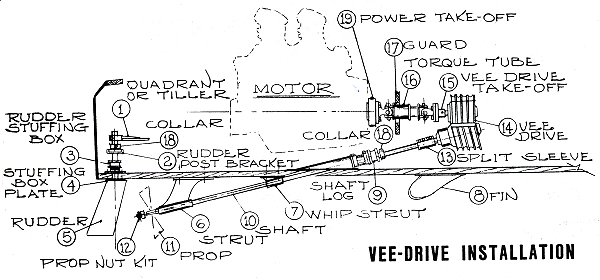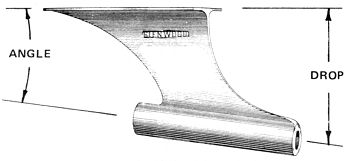Outfitting your Inboard Boat
Posted by Gayle Brantuk on Apr 8th 2011
During the first part of every year is when people start outfitting their boats for the upcoming boating season. It’s at this time that we get many calls from folks asking for help with choosing hardware for their inboards. I thought it would be helpful to go over some of the parts needed. If you’re unfamiliar with inboard installations, we suggest our book, Inboard Motor Installations.
The following is a description of the various parts and their function in an inboard boat. Refer to the “V-Drive Installation” sketch to determine the location of the parts listed below. Click on the part name in blue to view that item in the Glen-L online store. Although the sketch depicts a v-drive installation, a direct in-line drive would be similar from the v-drive aft.
Typical vee-drive installation
#1. QUADRANT or CUSTOM TILLER - A quadrant is required when cable type steering is used. The custom tiller is required when single push-pull cable steering is used.
#2. RUDDER POST BRACKET - The rudder post bracket supports the upper portion of the rudder and provides a bearing for the turning forces from the rudder shaft. These brackets can be mounted between or on top of the motor stringers. To prevent the rudder from falling through the bottom of the boat, a safety collar is used on the rudder above the rudder post bracket.
#3 RUDDER STUFFING BOX - A rudder stuffing box prevents the water from entering the boat through the rudder shaft hole. Various types of seals or packing glands can be used. We recommend using the same type for the rudder as for the shaft log (#9). The packing-type gland may be repacked while the shaft is in the boat. The seal-type requires that the shaft be removed to replace the rubber Neoprene seal. This is why we’ve always preferred the stuffing type boxes–plus, you can stuff them with shoestrings or whatever you have on hand in a pinch.
#4. RUDDER STUFFING BOX PLATE - The rudder stuffing box plate goes on the outside of the boat. It is optional and often not used on faster boats. It does provide a solid bolting and bearing for the bottom portion of the rudder stuffing box.
#5. RUDDER – Rudders of varying size and shape are listed to suit almost any small boat. Rudder Shafts (1″ or 1-1/8″) must be matched to the rudder stuffing box, collar, and rudder post bracket.
#6. STRUT – Struts are available in varying angles and drops to match your installation. Drop is the distance vertically from the base of the strut to the centerline of the strut bearing on the aft end of the strut. Two types of bearings can be obtained for most struts. The Aqua-Lube is a micarta-type bearing. The BJ is a rubber-type bearing and is recommended when the boat is to be used in silty waters. Strut bearings are replaceable.
#7. WHIP STRUT - Whip struts are used to prevent deflection or whipping of the shaft in high speed boats with flatter shaft angles.
#8. FIN – The “V” fin has a vee in the base to fit the vee in the bottom of most boats. The Flat Base fins are usually intended for smaller flat bottomed boats.
#9. SHAFT LOG - The shaft log prevents water from coming in through the shaft hole in the bottom of the boat. Shaft logs are available in varying angles to match the shaft or strut angularity. You’ll also need a stuffing box (Refer to #3 RUDDER STUFFING BOX for information as to the types of packing gland), hose and two clamps to complete the shaft log assembly.
#10. PROP SHAFT - Shafts come in standard lengths as noted. Shafts can be cut to the length needed and keyed on the driving end without additional cost. We offer three types of shafts; 303 Stainless Steel, 17-4 Stainless Steel and K-500 Monel. The most common is the 303 Stainless.
#11. PROPELLERS – For all around use, the three-blade conventional-type propeller is generally used. Direction of rotation must be specified. Direction of rotation of the prop is as viewed from the back of the boat looking forward – left hand counterclockwise; right hand clockwise. All propellers are intended to fit our propeller shafts and have standard 1″ tapers. Prop size and pitch are based on the motor and boat. Michigan Wheel has an extensive database on their website that can help you determine the best prop for your boat.
#12. PROP NUT KIT - A prop nut kit furnishes the parts necessary to securely hold the propeller on to the shaft.
#14. V-DRIVE MOUNT AND V-DRIVE - V-drives can be obtained that include integral forward, neutral and reverse gears. Others contain forward and neutral, while there are those that have no reversing or neutral position. With the latter, a marine transmission should be used on the motor. The exception to the latter statement would be for full race purposes. Ratios of the v-drives will vary.
#15. V-DRIVE TAKE-OFF - A vee drive flange take-off is used to couple the upper shaft of the v-drive to the torque tube. This flange take-off can be obtained with a vee pulley to drive generators, alternators or other appendages.
#16. TORQUE TUBE - Torque tubes are used to couple the motor to the v-drive or a jet pump. Two series are available, a #1310 and a #1350. For ordinary use with conventional pleasure boats and motors to approximately 400 cubic inches and a torque tube 24″ or shorter, the #1310 series is satisfactory. For larger engines and for high speed use, the heavy duty #1350 series is desirable. Note that the motor power take-off and the v-drive take-off must be of the correct series to match the torque tube. The torque tube does have “play” in the spline that will make it approximately 1″ shorter or longer than the noted dimensions. If a length other than those listed is needed, the torque tube can be cut and sized to your specifications.
#17. TORQUE TUBE GUARD - A torque tube guard protects the boat and occupants if a failure should occur anywhere along the torque tube assembly. Ordinarily, these are desirable on any of the higher speed boats with torque tubes 24″ or longer. Note that these are made to accommodate both the #1310 and #1350 torque tube series. (See #16.)
#18. SAFETY COLLARS - Safety collars are used on top of the RUDDER POST BRACKET (#2) and in high speed craft just aft of the strut or forward of the shaft log as a safety device. Either split or conventional collars are available.
#19. POWER TAKE-OFF - A power take-off connects the motor to the torque tube. The Series #1350 or #1310 must match the torque tube. Drives are available for taking the power from the front end, the flywheel end or from a marine transmission. In most cases, the drive will be from the flywheel end. In many cases, driving from the front end is impractical with motors equipped with harmonic balancers or those with small diameter crank shafts at the driving end.
I hope this helps. We have inboard hardware recommendations for many of our designs online. This listing will be in the online catalog in the “Notes” section of the page that lists the details for the design you’re interested in. If you can’t find it or need help choosing parts, give us a call and we’ll do our best to determine what you need.
_______________________________
Glen-L Words of the Week:
I/O (Inboard/outboard)
-
A propulsion system that uses an inboard motor, mounted at the transom, with a propeller assembly, similar to the bottom of an outboard, mounted on the outside of the transom, bolting to the motor with the transom sandwiched between. Also called a stern drive. In most designs it can be used optionally to a v-drive, or jet drive.
IN-LINE INBOARD ENGINES
-
A centrally mounted inboard, with the prop shaft usually coming directly off the engine or transmission; in-line with the engine.


